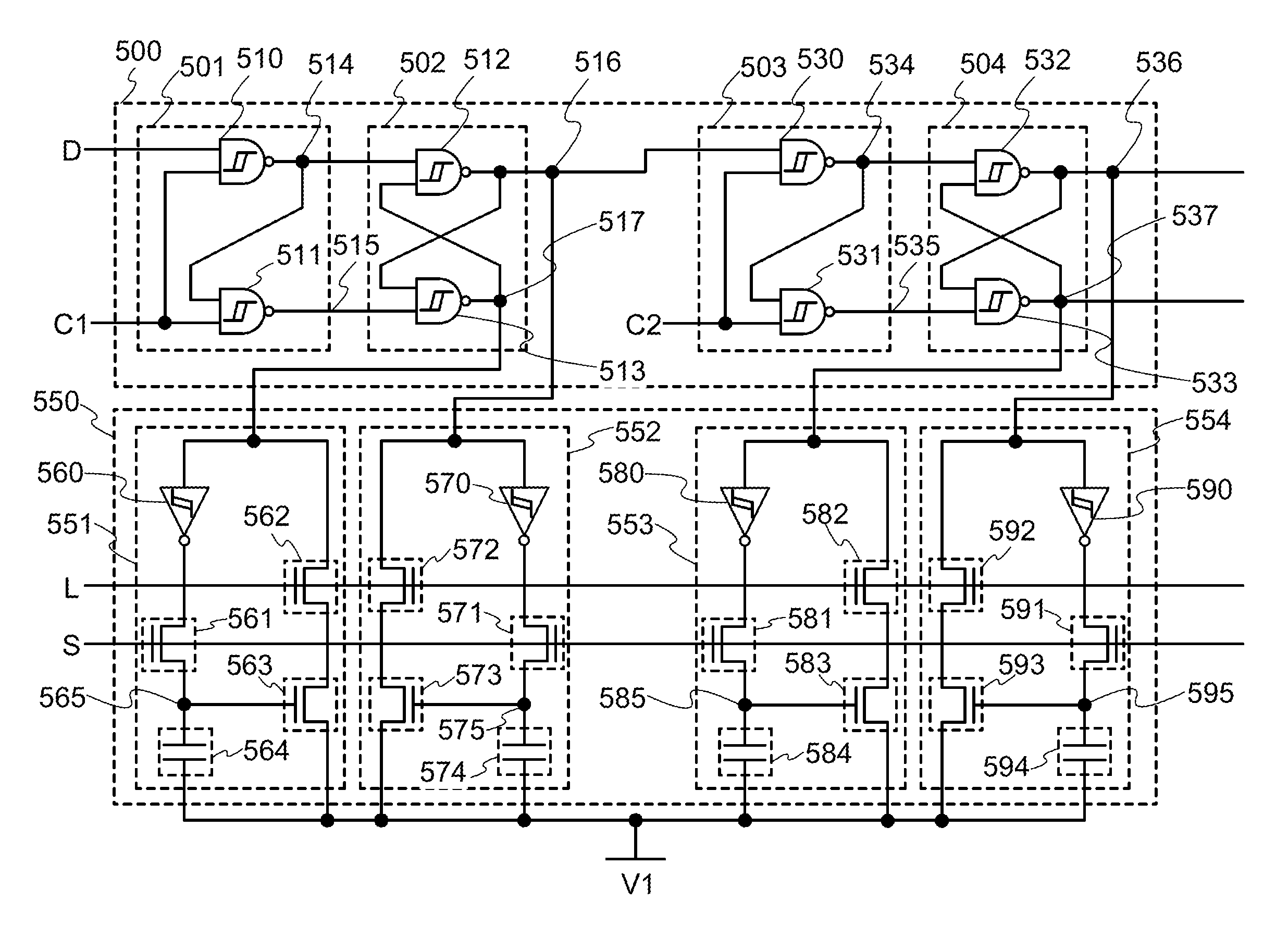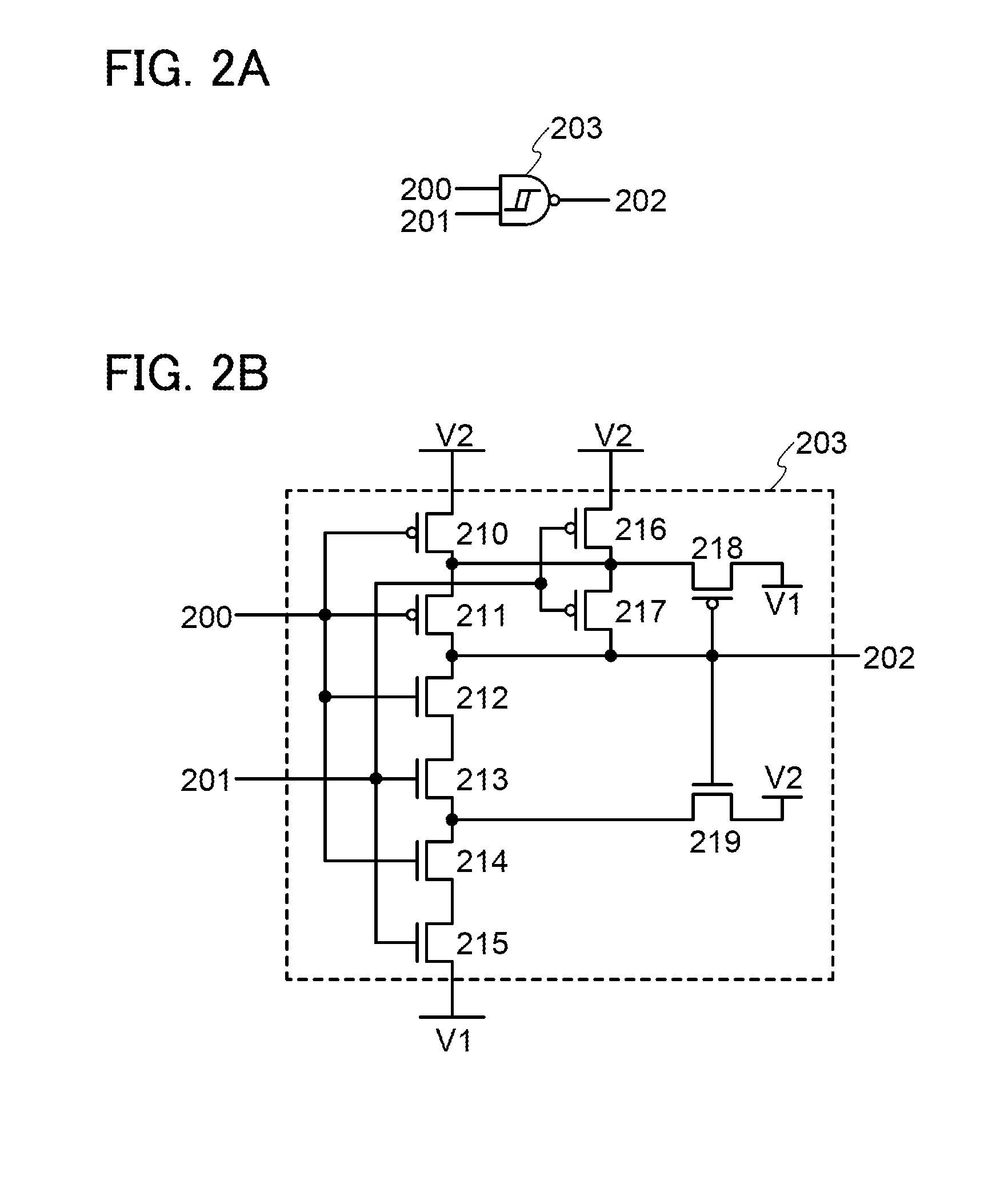Semiconductor device
- Summary
- Abstract
- Description
- Claims
- Application Information
AI Technical Summary
Benefits of technology
Problems solved by technology
Method used
Image
Examples
embodiment 1
[0036]In this embodiment, an example of a semiconductor device including a nonvolatile portion and a volatile portion is described.
[0037]FIG. 1 is a circuit diagram of a latch circuit. The latch circuit illustrated in FIG. 1 includes a first memory circuit portion 100 and a second memory circuit portion 150. The first memory circuit portion 100 has a function of holding a potential corresponding to data in a period when power supply voltage is continuously supplied. The second memory circuit portion 150 has a function of holding a potential corresponding to data in a period when the supply of power supply voltage is stopped.
[0038]The first memory circuit portion 100 includes a gate portion 101 and a latch portion 102.
[0039]The gate portion 101 includes a Schmitt trigger NAND circuit (hereinafter also referred to as ST-NAND) 110 and an ST-NAND 111.
[0040]A first input terminal of the ST-NAND 110 is electrically connected to a wiring to which a data signal D is supplied. A second input...
embodiment 2
[0105]In this embodiment, an example of a semiconductor device including a nonvolatile portion and a volatile portion is described.
[0106]FIG. 5 is a circuit diagram of a flip-flop circuit. The flip-flop circuit illustrated in FIG. 5 includes a first memory circuit portion 500 and a second memory circuit portion 550. The first memory circuit portion 500 has a function of holding a potential corresponding to data in a period when power supply voltage is continuously supplied. The second memory circuit portion 550 has a function of holding a potential corresponding to data in a period when the supply of power supply voltage is stopped.
[0107]The first memory circuit portion 500 includes a gate portion 501, a master latch 502, a gate portion 503, and a slave latch 504.
[0108]The gate portion 501 includes an ST-NAND 510 and an ST-NAND 511.
[0109]A first input terminal of the ST-NAND 510 is electrically connected to a wiring to which a data signal D is supplied. A second input terminal of th...
embodiment 3
[0164]In this embodiment, an example of a semiconductor device including a nonvolatile portion and a volatile portion is described.
[0165]FIG. 7 is a circuit diagram of a flip-flop circuit. The flip-flop circuit illustrated in FIG. 7 has a configuration different from that of the flip-flop circuit illustrated in FIG. 5. The flip-flop circuit illustrated in FIG. 7 includes a first memory circuit portion 400 and a second memory circuit portion 450. The first memory circuit portion 400 has a function of holding a potential corresponding to data in a period when power supply voltage is continuously supplied. The second memory circuit portion 450 has a function of holding a potential corresponding to data in a period when the supply of power supply voltage is stopped.
[0166]The first memory circuit portion 400 includes a gate portion 401 and a latch portion 402.
[0167]The gate portion 401 includes an ST-NAND 410, an ST-NAND 411, an ST-NAND 412, a Schmitt trigger AND circuit (hereinafter als...
PUM
 Login to View More
Login to View More Abstract
Description
Claims
Application Information
 Login to View More
Login to View More - R&D
- Intellectual Property
- Life Sciences
- Materials
- Tech Scout
- Unparalleled Data Quality
- Higher Quality Content
- 60% Fewer Hallucinations
Browse by: Latest US Patents, China's latest patents, Technical Efficacy Thesaurus, Application Domain, Technology Topic, Popular Technical Reports.
© 2025 PatSnap. All rights reserved.Legal|Privacy policy|Modern Slavery Act Transparency Statement|Sitemap|About US| Contact US: help@patsnap.com



